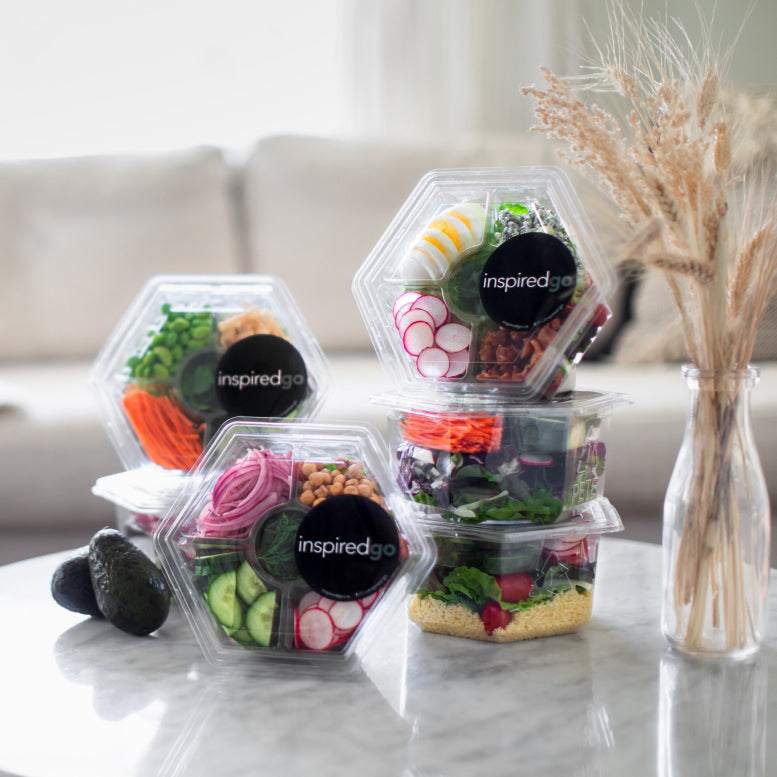Is It Healthy To Eat Salad Every Day?
Table of Contents
1. Is It Healthy To Eat Salad Every Day?
2. How Many Calories Are in a Salad?
3. How Many Calories in Chicken and Salad?
4. How Many Calories Are in a Taco Salad?
1. Is It Healthy To Eat Salad Every Day?
While salads are often associated with healthy eating, it's important to note that not all salads are created equal. Consuming a salad daily can be a beneficial part of a balanced diet, provided it's packed with a variety of nutrient-dense ingredients. It's best to opt for salads filled with fresh vegetables, lean proteins, and healthy fats. Complex carbs like whole grains can also be a great addition. Avoid heavy dressings and excessive cheese or croutons to keep your salad on the healthier side. Inspired Go offers a diverse range of nutrient-packed salads like the Everything Bagel Salad and Classic Fattoush Salad, ensuring you enjoy unique flavors and wholesome ingredients. These ready-to-eat meals are created with locally sourced ingredients and chef-inspired recipes, allowing you to maintain a balanced diet conveniently and deliciously.
Order fresh salads today →


2. How Many Calories Are in a Salad?
The calorie content of a salad varies depending on its ingredients, portion size, and dressing. Salads featuring leafy greens, fresh vegetables, and lean proteins are typically low in calories while being nutrient-dense. However, adding ingredients like creamy dressings, croutons, or fried proteins can significantly increase calorie counts. A basic garden salad might contain fewer than 150 calories, while a chicken Caesar salad with dressing can range from 500–800 calories. Salad delivery services often provide detailed nutritional information, helping customers make informed choices about their meals. Pre-portioned salads reduce the risk of overeating and ensure balanced nutrition. With access to transparent calorie counts, customers can confidently enjoy delicious, satisfying salads that align with their dietary goals.
Choose your salads and schedule delivery →
3. How Many Calories in Chicken and Salad?
Chicken salads are a popular meal option, combining lean protein with fresh vegetables for a balanced, satisfying dish. The calorie count in a chicken salad depends on factors like chicken preparation, dressing choice, and additional toppings. Grilled chicken typically adds fewer calories compared to fried or breaded chicken. A standard grilled chicken salad usually contains between 300–500 calories, while creamier dressings and fried chicken can push calorie counts higher. Salad delivery services provide clear nutritional information, allowing customers to make informed choices about their orders. With options to customize salads—such as choosing low-calorie dressings or extra vegetables—customers can easily tailor their meals to fit their dietary goals.
Get fresh salads and snacks delivered →
4. How Many Calories Are in a Taco Salad?
Taco salads are a popular fusion of fresh greens and bold Mexican flavors, offering a satisfying mix of crunchy textures, zesty dressings, and hearty toppings. However, traditional taco salads can vary significantly in calorie content, depending on ingredients like fried tortilla shells, heavy dressings, and excess cheese. Finding a delicious yet balanced version can be a challenge for those looking to maintain a mindful diet. Inspired Go’s Chipotle Taco Salad delivers the perfect harmony of flavor and nutrition, offering 390 calories, 15g of protein, and 4g of fiber per serving. Designed for maximum freshness and enjoyment, this salad features a crisp blend of red peppers, black beans, corn, Monterey Jack and cheddar cheese, and pickled onions. The house-made Greek yogurt chipotle lime dressing adds a creamy, tangy kick while keeping the calorie count in check.
Try our fresh, ready-to-eat salads →
Frequently Asked Questions
The most nutritious salad greens are dark leafy varieties like spinach, kale, and arugula. These greens are packed with essential vitamins, including A, C, and K, as well as minerals like calcium and iron. Kale is particularly rich in antioxidants, while spinach offers significant amounts of folate and magnesium. Choosing a mix of dark greens enhances both the flavor and nutritional value of your salad.
A healthy salad includes a balance of nutrient-dense ingredients like leafy greens, fresh vegetables, lean proteins, and healthy fats. For example, a base of spinach and kale, paired with grilled chicken, cherry tomatoes, avocado, and a light olive oil dressing, creates a wholesome meal. Avoid fried toppings or sugary dressings, as they add empty calories, and opt for natural ingredients to maximize nutrition.
Yes, eating salad daily is a healthy habit when it includes a variety of fresh, nutrient-rich ingredients. Salads offer fiber for digestion, antioxidants for immunity, and essential nutrients like potassium and folate. Regularly eating salads can support weight management and improve energy levels. To avoid monotony, vary your greens, proteins, and toppings to keep meals satisfying and nutritionally balanced.
Healthy salad dressings are typically made with simple, natural ingredients. Olive oil-based dressings, paired with balsamic vinegar or fresh lemon juice, provide healthy fats and enhance flavor without unnecessary calories. Avoid store-bought dressings with high sugar or preservatives. For a creamy alternative, opt for homemade dressings using Greek yogurt or avocado for added nutritional benefits.
Yes, salads are incredibly beneficial for overall health when prepared with fresh, whole ingredients. They are low in calories and high in vitamins, minerals, and antioxidants, supporting heart health, digestion, and immunity. Adding a mix of proteins and healthy fats creates a satisfying, nutrient-dense meal. Regularly incorporating salads into your diet can promote long-term well-being and energy.

